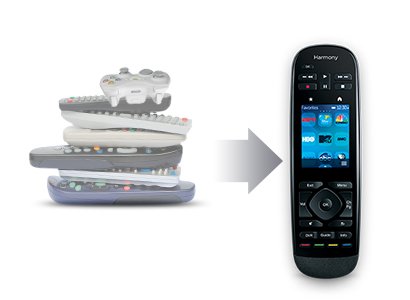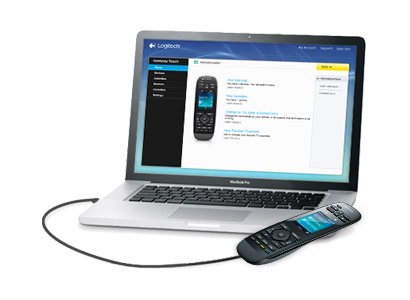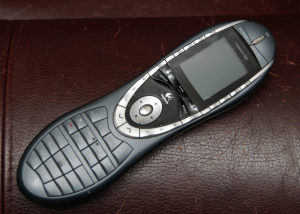 Practically every consumer electronic device seems to come with one these days. Your TV, DVD or Blu-ray, cable receiver, AV receiver, media streaming box and even your computer probably came with a remote. More than likely you have a drawer full of them somewhere in your house. It can make trying to get even simple tasks like switching the TV to the right input, adjusting volume and changing the channel difficult without requiring three different remotes. Some of these remotes may tout universal features by programming in codes for your other devices but beyond simple tasks the buttons on the one universal generally fail to control everything you need.
Practically every consumer electronic device seems to come with one these days. Your TV, DVD or Blu-ray, cable receiver, AV receiver, media streaming box and even your computer probably came with a remote. More than likely you have a drawer full of them somewhere in your house. It can make trying to get even simple tasks like switching the TV to the right input, adjusting volume and changing the channel difficult without requiring three different remotes. Some of these remotes may tout universal features by programming in codes for your other devices but beyond simple tasks the buttons on the one universal generally fail to control everything you need.
Smart remotes go beyond just having the ability to control multiple devices. They often provide a single button action to control multiple devices for simple task. They also have the ability to adjust as newer devices get added to your home theater setup something the universal remote functions that come with individual devices rarely can. Logitech’s Harmony remotes are some of the most popular smart remotes available but what exactly can they do and why should you consider getting one?
How It All Works
The real reason that the Harmony remotes work so well is that it keeps track of all of the devices that you have in your home theater setup and what state they are in. By knowing this information, it can adjust all of the various settings on the devices whenever your press an individual activity button on the remote. For instance, if everything is off and you press the button to watch your Roku, it knows to turn on the TV, turn on the receiver, set the TV input, set your receiver input and then have your volume buttons adjust the receiver while the directional buttons control the Roku. If you then decide to watch a Blu-ray movie, it knows that it should switch the TV input and receiver input as necessary and turn on the Blu-ray player.
For the most part, users will primarily be using just the activity buttons and maybe the volume and direction buttons to use the devices in question. The remote though has all of the various features from the remotes mapped to the various buttons as well so that you can use all of the functions for the appropriate devices in use as well.
Setup
 The most difficult part of dealing with the Harmony remotes is the setup. In order for the remote to function at its best, you need to be able to have it know all of the components that are in your system and how they are all connected. Essentially, before you begin, you want to create a map of your home theater setup. This should include the brand and model of each of the devices you have connected and the various wiring diagrams so you know which inputs the various devices will be using between devices.
The most difficult part of dealing with the Harmony remotes is the setup. In order for the remote to function at its best, you need to be able to have it know all of the components that are in your system and how they are all connected. Essentially, before you begin, you want to create a map of your home theater setup. This should include the brand and model of each of the devices you have connected and the various wiring diagrams so you know which inputs the various devices will be using between devices.
Once you have built your device map, you then need to go into the website to register all of the devices and how they are connected. As you do this, you will be asked questions such as is the volume controlled by the TV or the receiver. This helps it build the basic profile of how the remote will work. After you have it all in, it will send the profiles to the remote and it is time for testing.
This is where the real work begins. If you are lucky, the remote profiles will work flawlessly. More than likely you will have to make adjustments. For instance, if you have older devices or even brand new ones, the profiles may be somewhat incomplete. You may try the activity button for instance and find out that it takes a while for the TV to turn on before it will accept the input change command. This means you have to go into the specific activity program remote commands and either insert a delay or maybe move the TV input command later in the command list. This is very much a trial and error process. Each time you make the change, it has to be uploaded to the remote and tested again.
In addition to tweaking the activity buttons, you may want to adjust any custom buttons as well. For instance, my Harmony 880 remote has an LCD display that shows up eight commands at a time on the LCD screen when in a specific activity for use with features for the devices assigned to that activity. Sometimes the feature you may frequently used might be buried on a later page rather than the default. At this point, you can rearrange or set specific functions to buttons as well.
Using the Remote
 While the setup process can be cumbersome especially if you have to tweak the settings to get everything just right, using the remote after it is all setup is a joy. The ability to control everything from a single remote that works and having to press just a single button to switch between devices or turn on and off specific components as necessary makes it all worth it. Also, once it is all setup, you generally do not need to adjust the remote configuration unless you replace or add a component to our home theater setup, something most people do not do very frequently.
While the setup process can be cumbersome especially if you have to tweak the settings to get everything just right, using the remote after it is all setup is a joy. The ability to control everything from a single remote that works and having to press just a single button to switch between devices or turn on and off specific components as necessary makes it all worth it. Also, once it is all setup, you generally do not need to adjust the remote configuration unless you replace or add a component to our home theater setup, something most people do not do very frequently.
The lithium battery in some of the remotes will also work from some time before requiring charging. My ten year old remote still has the original battery which lasts about a month before needed charge and this is with it having a reduced life from being so old. My only complaint with my model is that the charging cradle is difficult to use but this has been corrected with a new stand style charger.

